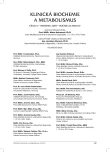Kidney stones - effect of indapamide treatment – a case study
Authors:
T. Šálek 1,2; I. Kurfürstová 1; M. Pšenčík 1
Authors‘ workplace:
Department of Clinical Biochemistry and pharmacology, Tomas Bata Hospital in Zlín a. s., Havlíčkovo nábřeží 600, 762 75 Zlín, Czech Republic
1; Medical Faculty of the University of Ostrava, Department of Biomedical sciences, Syllabova 19, 703 00 Ostrava – Zábřeh
2
Published in:
Klin. Biochem. Metab., 26, 2018, No. 4, p. 182-184
Overview
Objectives:
Identification of risk factors for kidney stone formation in patient with calcium kidney stone and demonstration of the effect of treatment.
Design:
A case study.
Settings:
Kidney stone clinic of Clinical biochemistry department, Tomas Bata Hospital Inc., Zlín
Material and methods:
Determination of kidney stones composition by polarized light microscopy and determination of biochemical risk factors in blood and 24 hour urine collection.
Results:
Decreased salt intake and administration of indapamide resulted in decreased urine calcium excretion from 12.88 mmol/24 hours to 5.97 mmol/24 hours.
Conclusion:
Identification of risk factors and its monitoring during treatment is the base of care of patients with kidney stones.
Keywords:
urolithiasis, indapamide, risk factors, calcium oxalate, calcium phosphate.
Sources
1. Scales, C., Smith, A., Hanley, J., Saigal, C. Prevalence of Kidney Stones in the United States. Eur. Urol., 2012, 62 (1), p. 160–165.
2. Stejskal, D. Etiopatogeneze a metafylaxe metabolických poruch a rizik urolitiazy. Urol. praxi. 2002, 3 (6), p. 234–241.
3. European Association of Urology. Guidelines on Urolithiasis [online]. [cit. 2017-05-21]. Dostupný z WWW: <http://uroweb.org/wp-content/uploads/22-Urolithiasis_LR_full.pdf>.
4. Friedecký, B. Kvalita v klinické laboratoři a bezpečnost pacientů. Klin. Biochem. Metab. 2010, 18(39), 2, p. 136–143.
5. Klátil, S., Hynčica, J., Šálek, T. Překvapivý nález cystinové urolitiázy u dospělé ženy. Urol. praxi. 2015, 16 (1), p. 33–35.
6. Shavit, L., Ferraro, P., Johri, N., Robertson, W., Walsh, S., Moochhala, S., Unwin, R. Effect of being overweight on urinary metabolic risk factors for kidney stone formation. Nephrol. Dial. Transplant. 2015, 30 (4), p. 607–613.
7. Taylor, E., Stampfer, M., Curhan, G. Diabetes mellitus and the risk of nephrolithiasis. Kidney Int. 2005, 68 (3), p. 1230–1235.
8. Lila, A., Sarathi, V., Jagtap, V., Bandgar, T., Menon, P., Shah, N. Renal manifestations of primary hyperparathyroidism. Indian. J. Endocrinol. Metab. 2012, 16 (2), p. 258.
9. Ogilvie, D., McCollum, J., Packer, S., Manning, J., Oyesiku, J., Muller, D., Harries, J. Urinary outputs of oxalate, calcium, and magnesium in children with intestinal disorders. Potential cause of renal calculi. Arch. Dis. Child. 1976, 51 (10), p. 790–795.
10. Šálek, T., Anděl, I. Kurfürstová, I. Topiramate induced metabolic acidosis and kidney stones - a case study. Biochem. Med. (Zagreb). 2017, 27 (2), p. 404–410.
11. Blackwood, A., Sagnella, G., Cook, D., Cappuccio, F. Urinary calcium excretion, sodium intake and blood pressure in a multi-ethnic population: results of the Wandsworth Heart and Stroke Study. J. Hum. Hypertens. 2001, 15 (4), p. 229–237.
12. American Urological Association. Medical Management of Kidney Stones [online]. [cit. 2017-05-21]. Dostupný z WWW: <http://www.auanet.org/guidelines/medical-management-of-kidney-stones-(2014)>.
13. Krieger, N., Asplin, J., Frick, K., Granja, I., Culbertson, A., Grynpas, M., Bushinsky, D. Effect of Potassium Citrate on Calcium Phosphate Stones in a Model of Hypercalciuria. J. Am. Soc. Nephrol. 2015, 26 (12), p. 3001–3008.
Labels
Clinical biochemistry Nuclear medicine Nutritive therapistArticle was published in
Clinical Biochemistry and Metabolism

2018 Issue 4
Most read in this issue
- Hyponatremia – Frequency, Causes, Pathobiochemistry, Clinics and Therapy.
- Hemolysis index as a tool for determination of free hemoglobin in plasma.
- Zeman M.: Refeeding syndrome after paleodiet
- Kidney stones - effect of indapamide treatment – a case study
